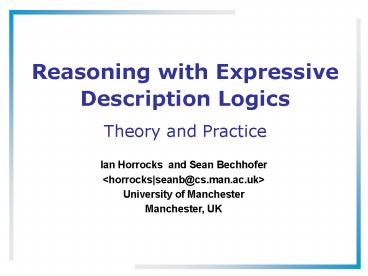Reasoning with Expressive Description Logics Theory and Practice - PowerPoint PPT Presentation
Title:
Reasoning with Expressive Description Logics Theory and Practice
Description:
Title: Overview Author: Sean Bechhofer Last modified by: Ian Horrocks Created Date: 5/22/2000 3:43:48 PM Document presentation format: On-screen Show – PowerPoint PPT presentation
Number of Views:164
Avg rating:3.0/5.0
Title: Reasoning with Expressive Description Logics Theory and Practice
1
Reasoning with Expressive Description
LogicsTheory and Practice
- Ian Horrocks and Sean Bechhofer
- lthorrocksseanb_at_cs.man.ac.ukgt
- University of Manchester
- Manchester, UK
2
- Talk Outline
- A Brief Introduction to the Semantic Web
- An Introduction to Description Logics
- Reasoning with OWL
- Why did that happen?
- Description Logic Reasoning
- How did that happen?
- Using Reasoning in Ontology Design
- Research Challenges
3
A Brief Introducitonto theSemantic Web
4
History of the Semantic Web
- Web was invented by Tim Berners-Lee (amongst
others), a physicist working at CERN - TBLs original vision of the Web was much more
ambitious than the reality of the existing
(syntactic) Web - TBL (and others) have since been working towards
realising this vision, which has become known as
the Semantic Web - E.g., article in May 2001 issue of Scientific
American
5
Scientific American, May 2001
Beware of the Hype!
- Realising the complete vision is too hard for
now (probably) - But we can make a start by adding semantic
annotation to web resources
6
Where we are Today the Syntactic Web
Hendler Miller 02
7
Hard Work using the Syntactic Web
Find images of Peter Patel-Schneider, Frank van
Harmelen and Alan Rector
Rev. Alan M. Gates, Associate Rector of the
Church of the Holy Spirit, Lake Forest, Illinois
8
Impossible (?) using the Syntactic Web
- Complex queries involving background knowledge
- Find information about animals that use sonar
but are neither bats nor dolphins - Locating information in data repositories
- Travel enquiries
- Prices of goods and services
- Results of human genome experiments
- Finding and using web services
- Visualise surface interactions between two
proteins - Delegating complex tasks to web agents
- Book me a holiday next weekend somewhere warm,
not too far away, and where they speak French or
English
9
What is the Problem?
- Consider a typical web page
- Markup consists of
- rendering information (e.g., font size and
colour) - Hyper-links to related content
- Semantic content is accessible to humans but not
(easily) to computers - Requires (at least) NL understanding
10
Adding Semantics
- External agreement on meaning of annotations
- E.g., Dublin Core
- Agree on the meaning of a set of annotation tags
- Problems with this approach
- Inflexible
- Limited number of things can be expressed
- Use Ontologies to specify meaning of annotations
- Ontologies provide a vocabulary of terms
- New terms can be formed by combining existing
ones - Meaning (semantics) of such terms is formally
specified - Can also specify relationships between terms in
multiple ontologies
11
A Semantic Web First Steps
Make web resources more accessible to automated
processes
- Extend existing rendering markup with semantic
markup - Metadata annotations that describe
content/funtion of web accessible resources - Use Ontologies to provide vocabulary for
annotations - Formal specification is accessible to machines
- A prerequisite is a standard web ontology
language - Need to agree common syntax before we can share
semantics - Syntactic web based on standards such as HTTP and
HTML
12
Ontology Design and Deployment
- Given key role of ontologies in the Semantic Web,
it will be essential to provide tools and
services to help users - Design and maintain high quality ontologies,
e.g. - Meaningful all named classes can have instances
- Correct captured intuitions of domain experts
- Minimally redundant no unintended synonyms
- Richly axiomatised (sufficiently) detailed
descriptions - Store (large numbers) of instances of ontology
classes, e.g. - Annotations from web pages
- Answer queries over ontology classes and
instances, e.g. - Find more general/specific classes
- Retrieve annotations/pages matching a given
description - Integrate and align multiple ontologies
13
Web Ontology Language Requirements
- Desirable features identified for Web Ontology
Language - Extends existing Web standards
- Such as XML, RDF, RDFS
- Easy to understand and use
- Should be based on familiar KR idioms
- Formally specified
- Of adequate expressive power
- Possible to provide automated reasoning support
14
From RDF to OWL
- Two languages developed to satisfy above
requirements - OIL developed by group of (largely) European
researchers (several from EU OntoKnowledge
project) - DAML-ONT developed by group of (largely) US
researchers (in DARPA DAML programme) - Efforts merged to produce DAMLOIL
- Development was carried out by Joint EU/US
Committee on Agent Markup Languages - Extends (DL subset of) RDF
- DAMLOIL submitted to W3C as basis for
standardisation - Web-Ontology (WebOnt) Working Group formed
- WebOnt group developed OWL language based on
DAMLOIL - OWL language now a W3C Candidate Recommendation
- Will soon become Proposed Recommendation
15
OWL Language
- Three species of OWL
- OWL full is union of OWL syntax and RDF
- OWL DL restricted to FOL fragment (¼ DAMLOIL)
- OWL Lite is simpler subset of OWL DL
- Semantic layering
- OWL DL ¼ OWL full within DL fragment
- OWL DL based on SHIQ Description Logic
- In fact it is equivalent to SHOIN(Dn) DL
- OWL DL Benefits from many years of DL research
- Well defined semantics
- Formal properties well understood (complexity,
decidability) - Known reasoning algorithms
- Implemented systems (highly optimised)
16
Acknowledgements
- Thanks to various people from whom I borrowed
material - Jeen Broekstra
- Carole Goble
- Frank van Harmelen
- Austin Tate
- Raphael Volz
- And thanks to all the people from whom they
borrowed it ?































